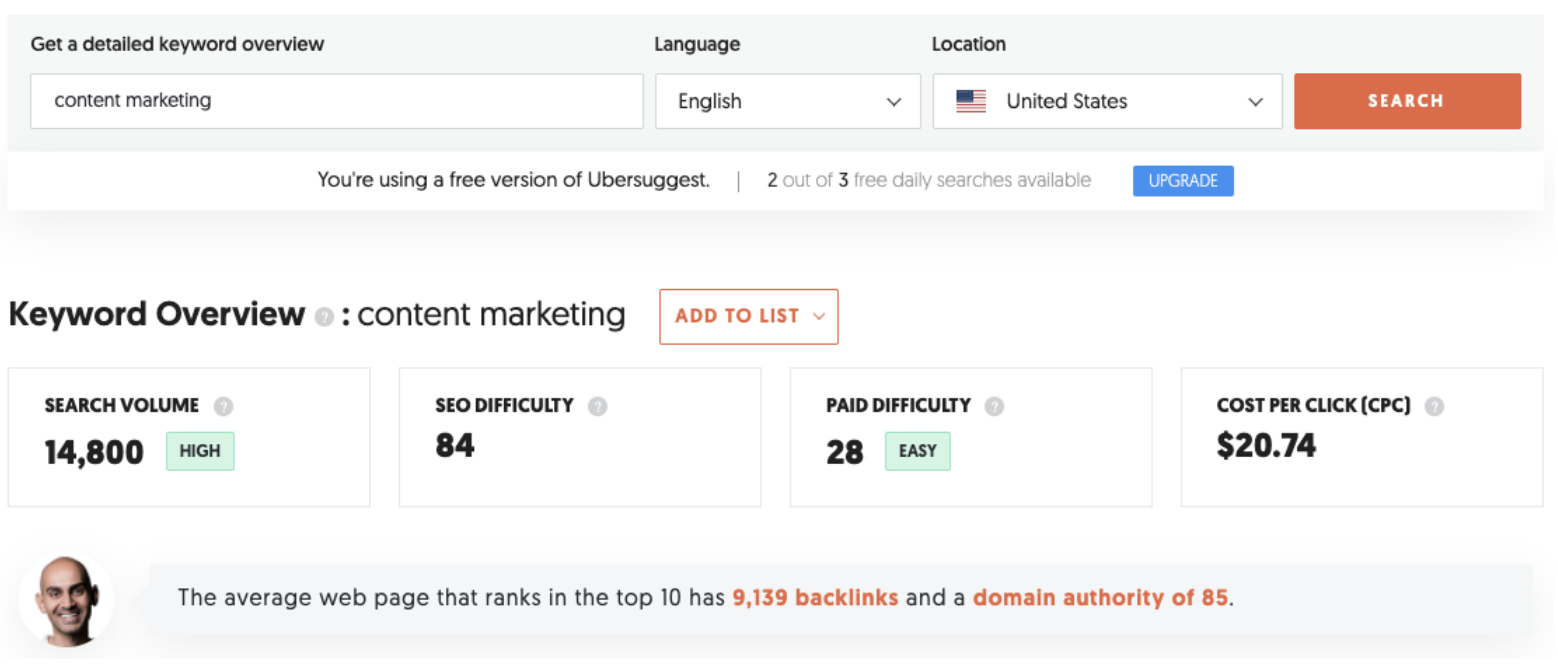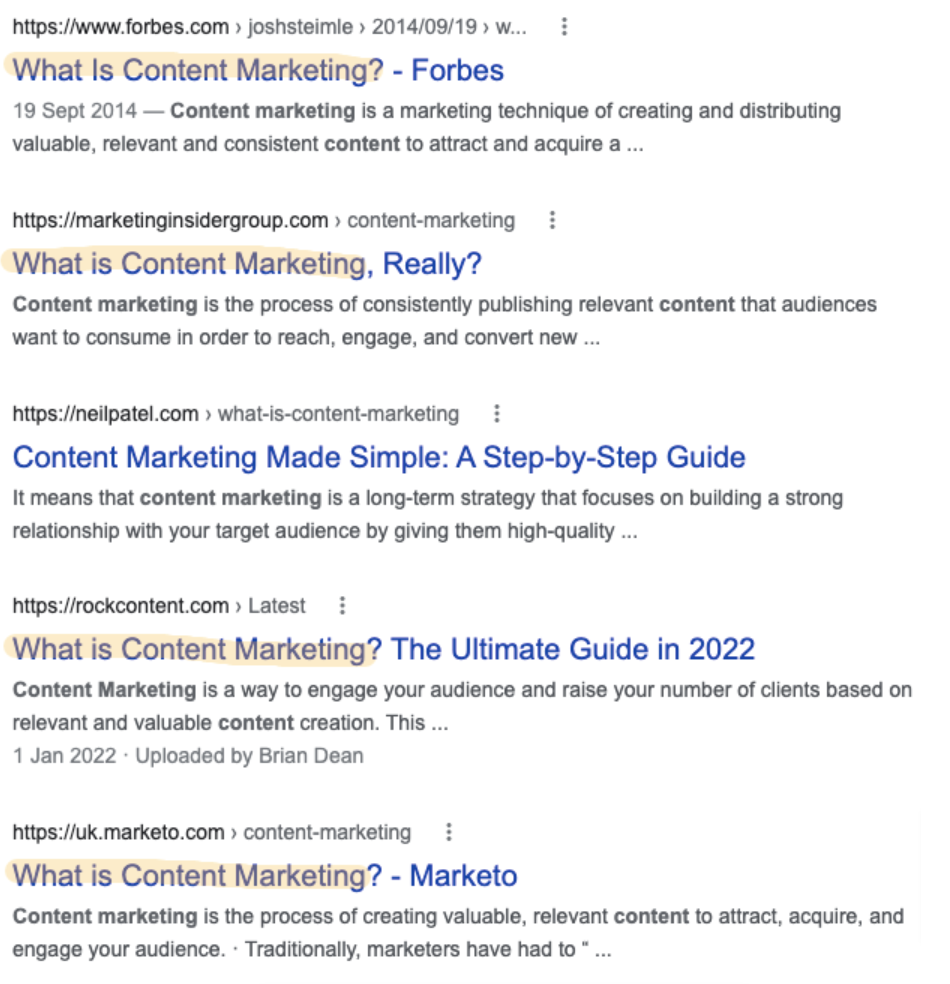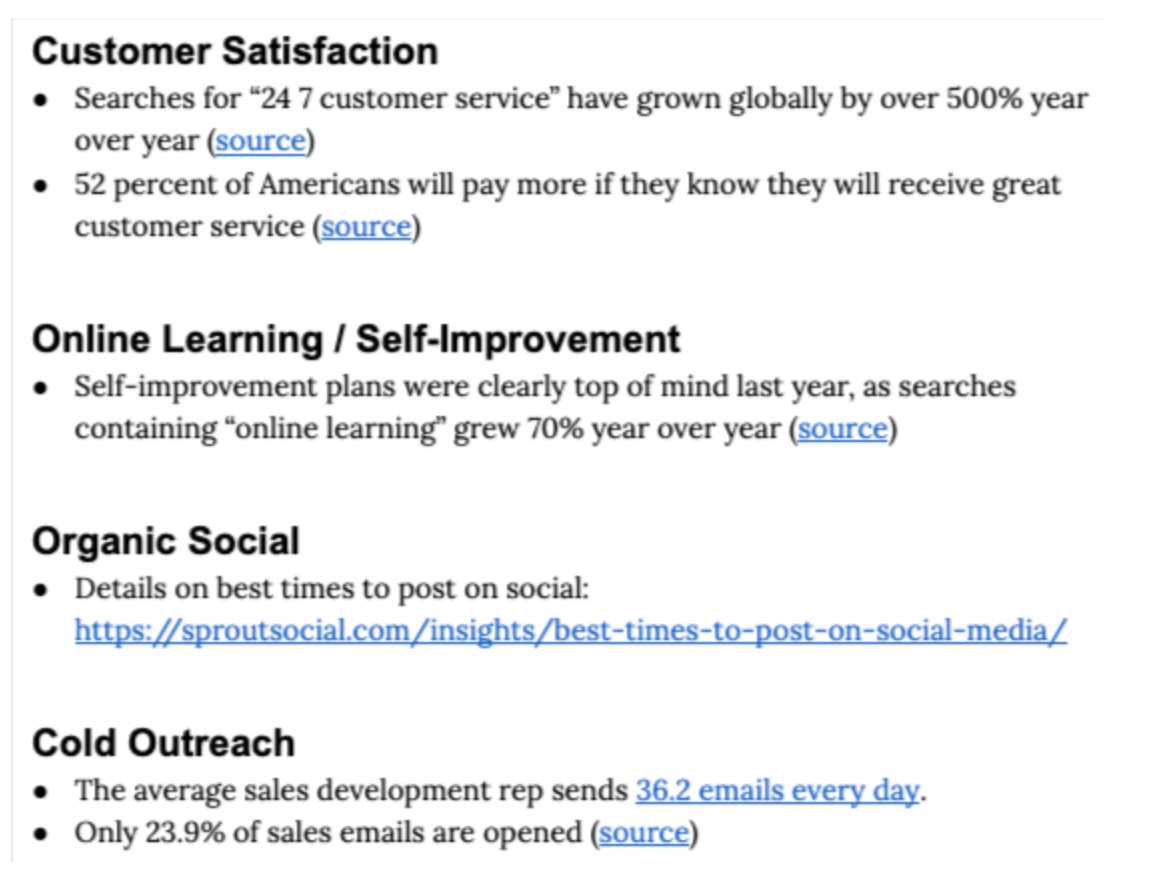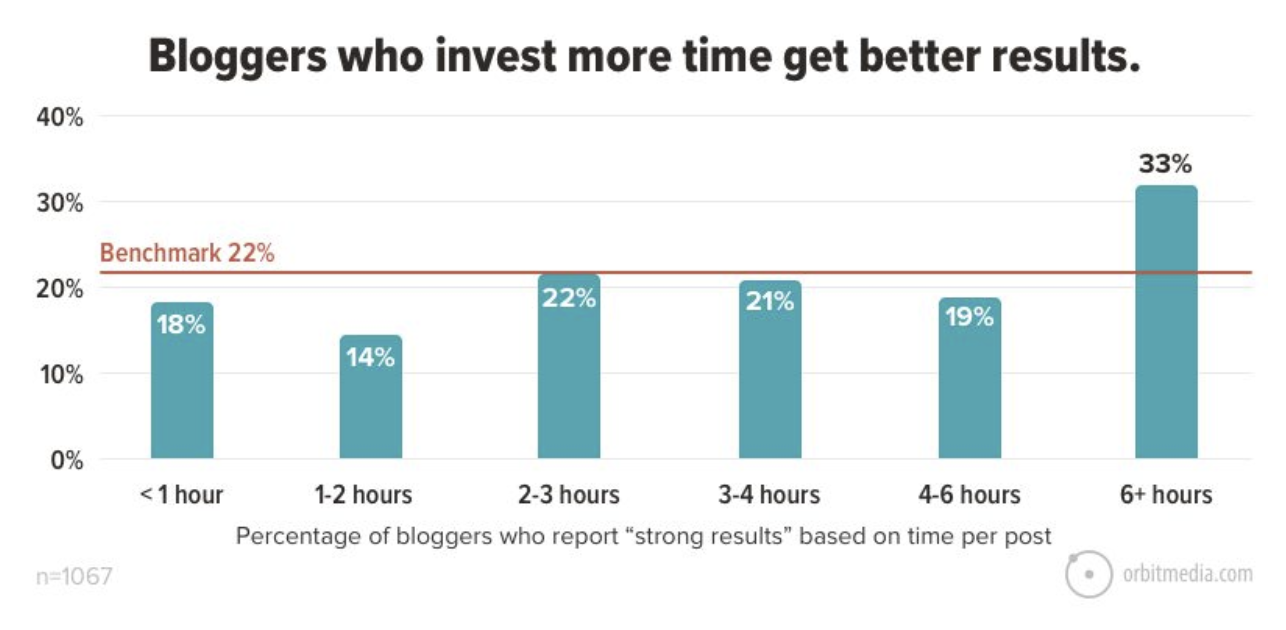Blogging sounds pretty damn simple.
You know your business like the back of your hand. You understand your industry. You can get into the head of your ideal customer.
So surely it’s a cinch to turn all that information into a blog post, right?
Well, maybe not.
We know from experience that writing a high-quality blog post — one that engages your audience, adds real value, and persuades them to come back for more — is anything but easy.
However, it becomes a lot less challenging if you start the blog writing process with a content outline — something that sets out your goals for the post, gathers together all the relevant research, and helps you create a logical flow from one point to the next.
With that in mind, let’s walk through a tried-and-trusted seven-step process for how to write a blog post outline.
1. Define Your Audience
The first step sounds simple, but it’s extremely important. You need to figure out who you’re writing for.
How much do they know about your industry and the products or services you sell?
Are they coming to you for some expert advice or a beginner-level intro to a subject they know little or nothing about?
Knowing the specific audience you’re writing for will help you later on in the content outline process when you’re deciding what information to include in your blog post.
2. Decide on Objectives
You’re not writing a blog post for the fun of it — you’re doing it to drive some sort of action from your website visitors. That action could be to:
- Start a free trial
- Download an ebook
- Register for a webinar
- Read a follow-up blog post
- Click through to a key page on your website
- Sign up for your email newsletter
- Request a product demo
- Contact your sales team
- Or take any number of other actions that serve your larger business goals.
Importantly, you should only attempt to drive one action per blog post.
If your article is geared toward driving newsletter signups and webinar registrations, that runs the risk of diluting your messaging and makes it less likely that readers will do either.
3. Identify Target Keywords
Even if the main purpose of your blog post isn’t to drive organic traffic, it still makes sense to have a main target keyword for each article (plus supplementary keywords where relevant).
Besides the SEO benefits of keyword targeting, there are two reasons you should identify keywords when outline your blog post:
- It’ll help you build a more focused content outline
- It’ll make your life easier during the research phase
So how do you find those juicy target keywords?
While they aren’t a replacement for a full SEO research process, there are lots of free tools that make the keyword research process easier.
For instance, Neil Patel’s Ubersuggest is useful for finding a “seed” keyword — that is, a short, generic term like “content marketing” — and giving you an idea of how easy (or difficult) it’ll be to rank for that term.
Having identified a high-volume seed keyword, you can try using Answer the Public to find longer-tail variants.
Those variants will have much lower search volumes — but on the flip side, they’ll be a lot more specific and far easier to rank for.
4. Craft a Working Title
Blog titles are important. In fact, they’re the most important words in your entire article.
Or, as advertising legend David Ogilvy put it: “Five times as many people read the headline as read the body copy. When you have written your headline, you have spent eighty cents out of your dollar.”
The keyword research phase should give you a leg up on writing a working title for your content outline.
But it’s not enough to simply take one of the long-tail terms you identified and turn it into a blog title.
Why?
Because everyone else has done the same thing!
Just take a look at this search engine results page (SERP) for the term “what is content marketing.”
Four out of five results, all on the first page of Google, contain the exact phrase “what is content marketing.”
The purpose of your headline is to compel people to click. While it is a good idea to understand the intent behind the articles Google is choosing to rank, it’s going to be tough to get clicks if you just write the same thing as everyone else.
5. Do Your Research
We’ve already mentioned the SERPs.
This is the point where you really need to dig into them. Because it pays to know what the competition is up to. That way, you can understand:
- What sort of content Google is ranking for a given query;
- And (because Google favors content that people actually engage with), what your audience wants to read.
Start by opening a blank Google Doc or Word document.
Then search for your target keyword on Google and read at least the first three results, taking the time to pull out key takeaways and useful bits of information as you go, and pasting them into your document.
Ideally, you’ll have time to skim through the rest of the results on page one, too.
Look out for useful statistics, links to original research, and visual elements like images, gifs, and videos while you’re at it. They give your blog post greater credibility, back up your arguments, and make it look a lot more engaging to the reader.
Pro tip: Consider creating a Google Sheets database of useful statistics you come across during the research phase of your blog post outline. That way, if you’re writing about similar topics time and time again, you’ll be able to consult your database, find a stat that fits and save time on future research.
However, there’s a problem.
Competitor analysis will only get you so far.
Specifically, if your research involves nothing more than reading the stuff your biggest rivals have already written, you’ll inevitably end up creating something extremely similar.
And while imitation might be the greatest form of flattery, it’s not going to help you stand out from the crowd.
That’s why you need to go a whole lot further to produce something that’s both totally unique and offers real value to your audience. For instance, consider:
- Interviewing team members: Who knows your customers better than your sales and accounts teams? Speak to them to get inside the head of your readers. Or talk to a subject matter expert on your team when you’re writing about complex, technical topics.
- Speaking to external experts: Don’t have the in-house expertise to adequately tackle an important topic? Or perhaps you want to tap into a thought leader’s audience? Either way, interviewing an external subject matter expert can help you out.
- Doing desktop research: Go beyond the SERP and carry out your own online research into the subject at hand. Search for original studies, surveys, and reports from credible sources to help formulate your argument and bring your content to life. Oh, and if you’ve got time, try listening to a relevant podcast or watching a video on the subject — there’s a good chance their insights won’t have appeared in written form before.
6. Build a Structure
By this point, you’ve got a lot of thoughts in your content outline document.
Some of those thoughts came from your competitor research; others from third-party sources; others still will be your own unique take on the subject.
Together, they’re a pretty random and disconnected bunch.
Now it’s time to bring some order to the madness.
Start by reminding yourself of your target audience.
If they’re total newcomers to the topic, it’s worth beginning your blog post by laying the groundwork with a “What is [X]?” section. But if they have a decent working knowledge of the subject matter, you’ll want to skip straight to the more advanced stuff.
Next, read through all the notes you took in the previous section and group them together into common themes.
Put those groups into some sort of logical order, based on the points you’d want to communicate to someone reading your blog post from top to bottom, and give each subsection a rough heading.
For instance, if you’re writing a blog post on content marketing for startups, and you’re targeting a beginner audience, your top-level structure might look like this:
- Intro
- What is content marketing?
- Benefits of content marketing for startups
- Content marketing tips for startups
- Conclusion
- Call to action
Clearly, it wouldn’t make sense to add the “content marketing tips” section before you’ve explained what content marketing is. And it makes sense to get the benefits in early, so that all the tips sound like they’ll be worth the effort.
7. Outline Your Headings
The final step of your blog post outline is simple, but important.
You’ve already got a relatively detailed structure. Now it’s time to polish it by turning those rough headings into snappy, optimized subheadings (and sub-subheadings, if necessary).
Those subheadings should contain primary and secondary keywords where possible (consult your keyword research from step three).
Your headings should be easy for speed-readers to scroll through and pick out relevant information, and they should compel visitors to keep on reading.
Here’s how our top-level structure might look after a little TLC:
- [H1] The ultimate guide to content marketing for startups
- Short intro
- [H2] What is content marketing?
- [H2] What are the benefits of content marketing for startups?
- [H3] Boost brand awareness
- [H3] Grow website traffic
- [H3] Build trust and authority
- [H3] Generate leads
- [H3] Nurture leads
- [H2] 5 killer content marketing tips for startups
- [H3] Write regular blog posts
- [H3] Create social-friendly content
- [H3] Post content at the right time
- [H3] Collaborate with thought leaders
- [H3] Use blogs to build backlinks
- [H2] Conclusion: Start leveraging the power of content marketing for startups today
- CTA: Contact our sales team
There Are No Shortcuts to Creating High-Quality Content
The fact is, creating a strong content outline takes time.
There aren’t really any shortcuts here. Sure, there are tools that can spit out an outline in five seconds by analyzing top-performing articles.
But you still need to absorb all the information and turn it into something valuable — otherwise no one’s going to want to read it. And those who do read it won’t take action, because the blog you’ve created isn’t useful.
So it’s no surprise that bloggers who report strong marketing results from their blogging activity spend the most time researching and writing each post.
Don’t have the resources to create incredible content yourself? We’d love to help! Get in touch with Content Conquered today 🙂





